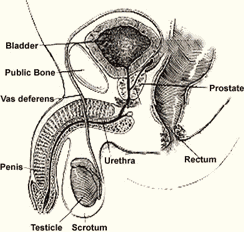|

INTERNAL ANATOMY
| Testes |
Epididymis | Seminal vesicles
| Vas deferens |
| The Prostrate gland | Corpa cavernosa
| Ejaculatory Ducts |

- Testes
The male sexual glands, testes are ovoid, somewhat rubbery structures, about 4.5 cm (3.5 to 5.5 cms) long in adults. The left usually lies somewhat lower than the right. The testes produce sperms and a hormone - testosterone. Testosterone stimulates the pubertal growth of the male genitalia, prostrate, and seminal vesicles. It also stimulates the development of masculine secondary sex characteristics, including the beard, body hair, muscle development and the male voice. Each testicle produces nearly 150 million sperm every 24 hours. One cycle of sperm production takes 3 months.
- Epididymis
On the back surface of each testis lies the softer, comma-shaped epididymis. The epididymis is where sperms mature. The sperm wait here until ejaculation or
nocturnal emission.
- Seminal vesicles
The seminal vesicles produce semen, a fluid that activates and
protects the sperm after it has left the penis during ejaculation
- Vas deferens
The ducts leading from the epididymis to the seminal vesicles. These are cut during
vasectomy.
- The Prostate gland
Also contributes to the semen. It also prevents urine from mixing with the semen
and disturbing the pH balance required by sperm, by squeezing shut the urethral duct to
the bladder.
- Corpa cavernosa
The corpora cavernosa are the two spongy bodies of erectile tissue on either side of
the penis, which become engorged with blood from arteries in the penis, thus causing
erection.
- Ejaculatory Ducts
The path through which semen travels during ejaculation.
|